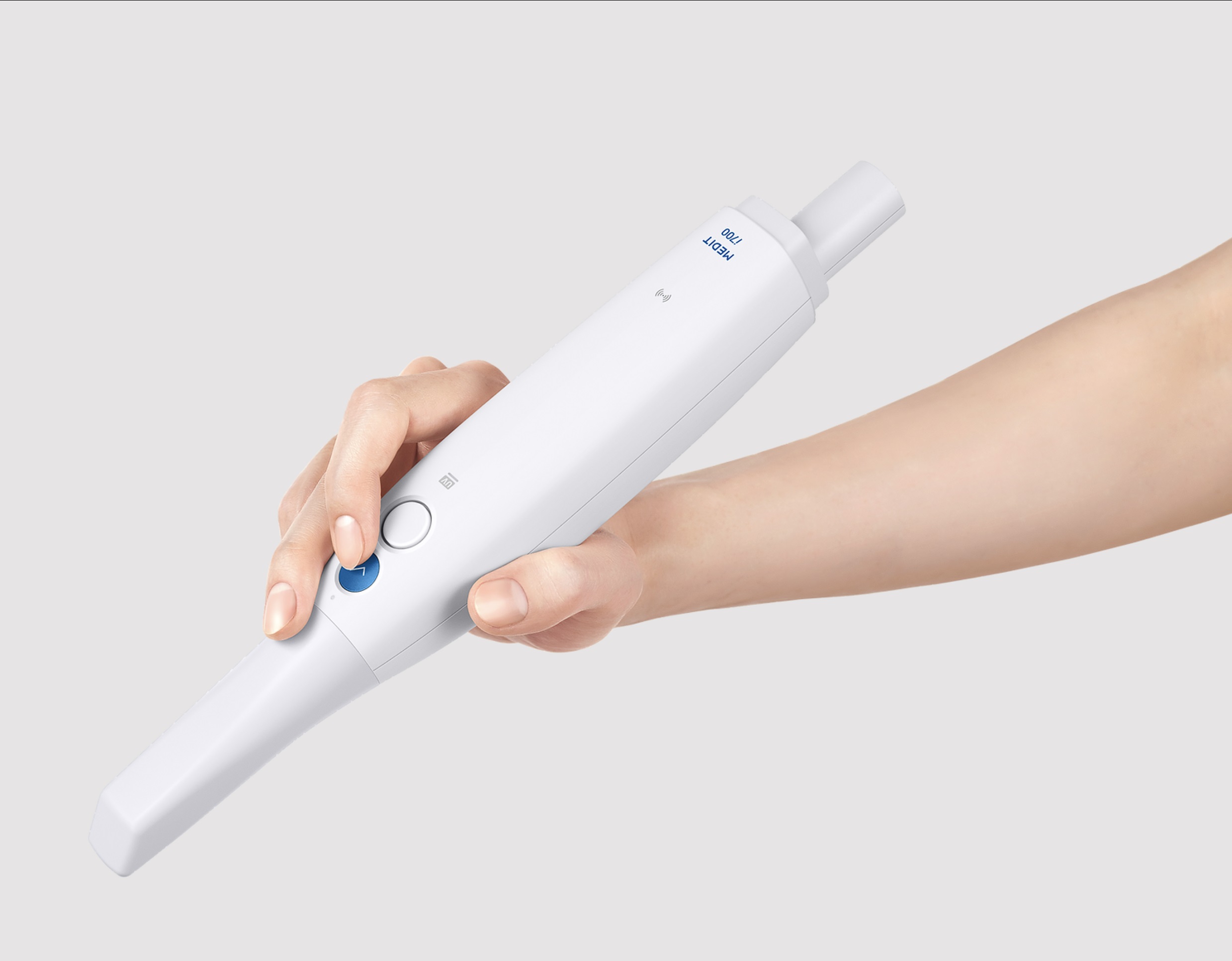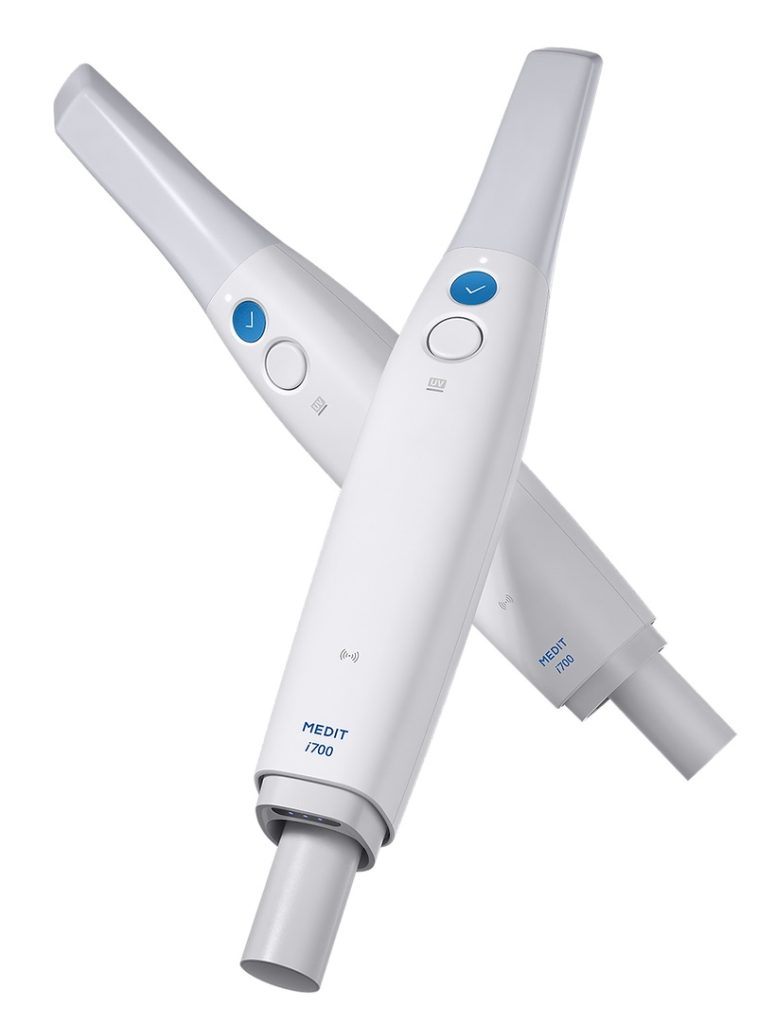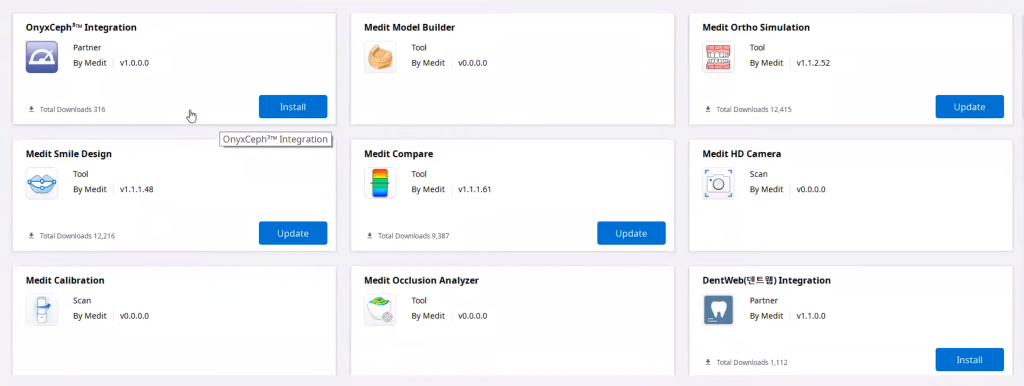
An intraoral scanner is one of the first steps you can take into digital dentistry. Having an intraoral scanner allows you to create digital impressions of your patient’s teeth, as opposed to having physical impressions take up space in your office.
Intraoral scanners are also more comfortable for the patient since they’re not gagging at that “icky” silicone resin. It also reduces error in the impression and lessens chair time for the patient.
However, intraoral scanners are pricey. And just like with any business investment, you need to weigh your options carefully — especially if they cost an arm and a leg. With that said, we turn to Dr. Chris Baer, dentist and owner of Baer Dental Design, for his expert opinion on IOS scanners.
Dr. Chris recommends looking at the Medit i700 Wireless Intraoral Scanner. Here’s why:
Design and Portability
For a device that you twist and maneuver around so much, having a wireless option is a fantastic feature.

The Medit i700 Wireless is a sleek and lightweight scanner that you can easily maneuver around in a patient’s mouth. Its 328g weight is evenly distributed across the length of the device, and there’s no cord to get in the way of your scanning.
In addition, the scanner comes with a detachable handle that you can place perpendicular to its length. This allows users to hold the scanner with a pistol grip. So you have a choice between a pen grip and the pistol grip, which is great for a variety of grips and hand types.
Reversible Tip
On the topic of ease-of-scanning, the i700 Wireless has a reversible tip. This allows chairside clinicians to scan both the maxilla and mandible without breaking their wrists.
Since the i700 is a wireless device, your setup could just consist of a plugged-in laptop, the wireless hub, and the intraoral scanner. This makes for a less-cluttered work area, freeing up your range of motion just a tad bit.
Wireless Connectivity
The common misconception around wireless devices, not just intraoral scanners, is that there’s latency. While this may have been a significant consideration back then, wireless technology has developed drastically over the years to emulate wired performance.
In the case of the Medit i700 Wireless, it connects to a computer device using 60 GHz wireless technology. That’s 24x faster than the highest-end wireless mouse.
The i700 Wireless comes packaged with its own wireless hub that you then connect to your device. You need to use the wireless hub in order to operate the wireless scanner. Also, the hub connects to USB 3.1 to maximize data speeds for a much smoother scanning experience.
Dr. Chris Baer uses both the wired and wireless i700 for his practice. He mentions that there’s no significant difference between the two when it comes to scanning.
Battery Life
As with any wireless device, the Medit i700 Wireless intraoral scanner relies on batteries to operate wire-free. Medit boasts one hour of continuous scanning with the i700 or eight hours in standby mode before needing to change batteries.
The device’s built-in power management function also allows it to sleep when not in use, conserving the battery for you. The i700 comes packaged with three rechargeable batteries, allowing you to cycle through them during a busy day.
In the event that all three batteries run out of juice, the i700 also comes with a power cord that you can plug straight into a power source. This allows you to use it like the corded Medit i700.
Dr. Chris Baer shares his battery experience with the i700 Wireless in an Evident webinar. He mentions that the i700 Wireless can scan up to eight full arches on a single charge before getting a low battery notification.
Software
The Medit i700 Wireless comes with the Medit Link, its accompanying software that will help you maximize its use.
Medit Link enables dental professionals to store, manage, and share their digital impressions and designs securely and easily. It provides a centralized location for case management plus tools for case planning, communication, and collaboration with other dental professionals.

The platform also gives users access to Medit’s app store, which includes smile design software, an occlusion simulator, and an ortho simulator, among others.
In addition, Medit users are given 5TB of cloud storage to store their scans. This amount of space can hold approximately 372,000 traditional scans (upper, lower, and bite).
Going in-depth with the Medit Link could already be a review on its own.
Imaging Technology
The i700 wireless scans fast at 70 frames per second (fps). A chairside clinician can wave the i700 around a model like a wand, and they’ll get a complete image within a couple of minutes.
As for its accuracy and precision, the i700 Wireless scanner’s accuracy is listed as 10.9μm ± 0.98. This means that the difference between the captured digital impression and the actual surface averages at 10.9μm with a ± 0.98μm deviation from this average.
This means that the captured digital image is a precise model of the actual scanned object; deviating only by as much as 1/8ths of a hair’s width. This kind of precision is crucially important when scanning patients, especially for dental restoration purposes. A scanner with precise imaging makes it possible to create perfect-fitting crowns, bridges, titanium bars, and other prostheses.
Maintenance and Cleaning
The i700 Wireless can disinfect itself with its own UV light. This saves you the trouble of having to disinfect the device yourself.
The scanner’s tip is autoclavable up to 150 times. The recommended temperature and time for autoclavable sterilization cycles are as follows:
- 121°C for 30 minutes using a gravity-type autoclave
- 134°C for 4 minutes using a pre-vacuum type autoclave
- 135°C for 10 minutes using a gravity-type autoclave
In addition to disinfection, the i700 Wireless also comes with its own calibration tool. You can calibrate the scanner in your office without sending it back to your supplier or to Medit.
System Requirements
It’s important to note that the system requirements for the Medit i700 Wireless (or for any intraoral scanner) are quite demanding. You’ll need architect-level specs to fully utilize your Medit i700 Wireless.
The system requirements for the i700 are as follows:
CPU: Standard: Intel Core i5-12500H, Intel Core i5-12400, AMD Ryzen 5 5600X; High-Performance: Intel Core i7-12700H, Intel Core i7-12700K, AMD Ryzen 7 5800X;
RAM: 32GB
GPU: Standard: NVIDIA GeForce RTX 3060, NVIDIA RTX A3000; High-Performance: NVIDIA GeForce RTX 3070, NVIDIA RTX A5000
Digital dentistry is both CPU and GPU intensive, so if you’re building a PC to handle the i700 Wireless, you can’t compromise on either one of them. The RAM requirement is pretty hefty too, at 32 GB.
Building a PC to support the high-performance specs will cost you upwards of $1,500. Whereas laptops that meet high-performance specifications will set you back at about $2,000. However, hardware like this is a great investment if you wish to get into digital dentistry. The quicker, easier workflow will show its returns in no time.
Customer Support
The customer success team at Medit takes care of their customers. Upon purchase, you have access to a dedicated customer service team that can be reached by phone, email, or live chat. The team is available to help customers with any questions or issues they may have with their scanner. Dr. Baer mentions that he’s able to get in touch with a support rep within the hour, if not within a half-hour.
Medit also offers a range of online resources, including user manuals, training videos, and FAQs. These resources can help customers get the most out of their scanner and troubleshoot any issues they may encounter.
Additionally, the i700 Wireless comes with a one-year warranty that covers any defects in materials or workmanship. If a customer experiences any issues with their scanner during the warranty period, Medit will repair or replace the scanner free of charge.
Conclusion
Overall, the Medit i700 Wireless is a great intraoral scanner. It’s lightweight and portable for comfortable scanning, plus its imaging technology is microscopic-precise. As a wireless device, its connection is instantaneous, so you won’t feel any difference at all from the wired i700.
It’s important to note, though, that you’ll need a high-end laptop to properly utilize the imaging capabilities of the Medit i700 Wireless (or any intraoral scanner). You may need to do a bit of research into a laptop or desktop that will suit your digital dentistry needs.








